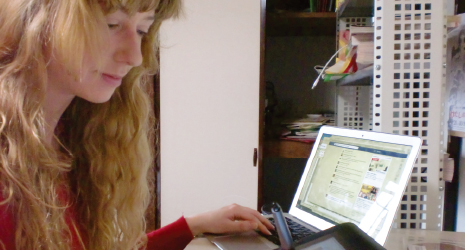Home > Highlighting JAPAN >Highlighting Japan April 2016>Subculture Immersion
Highlighting JAPAN


So Many Stories to Tell
As a teenager growing up in Sweden, artist and storyteller Asa Ekstrom fell in love with manga, going on to conceive, write and draw her own distinctive comics that have published in both her homeland and Japan.
The popularity of Japanese comics—typically called manga—reaches far beyond the shores of the island nation that created the genre, and they are constantly gaining fame and fans throughout the world. While plenty of non-Japanese now read and love manga, Swedish artist Asa Ekstrom went a step further to create and publish her own comics—and now produces them here in Japan as well.
“I never thought I’d become a manga artist,” Ekstrom says; and yet she recalls that when watching the anime series Sailor Moon as a teenager “it was the first time I had seen anime for girls, and that had a profound impact on me.” Ekstrom became a fan of reading and drawing manga during her teens, making regular excursions from the suburbs to Stockholm’s urban area to seek out English-language translations of the comics, since there were no Swedish translations available at the time.
Manga proved a natural fit. “I love writing stories and I love drawing, but discovering manga was the first time I realized you could put them together,” she notes. Ekstrom intended to pursue higher education, but took a year off to engage in her hobby at a comic arts school in Sweden. That proved to be a pivotal decision, because after a year Ekstrom says she began getting offers to draw for money. She has never looked back.
Ekstrom published her first Japanese-style comic in Sweden, a three-volume shojo manga (manga for female readers) called Sayonara September. Ekstrom describes that work, which ran almost seven hundred pages, as very personal: “The inspiration came from my own life about becoming a manga artist.”
After visiting Japan several times, Ekstrom decided to wholeheartedly pursue the study of Japanese, and moved to Tokyo in 2011. After a year at a language school, she enrolled in a graphic design college. Although Ekstrom contemplated working as a graphic designer, she ultimately found an opportunity in 2014 to create manga for major Japanese publisher Kadokawa.
Now Ekstrom works as a freelance artist, drawing and writing four-panel manga strips. She published two volumes of these strips in 2015 as Hokuo Joshi O-sa Ga Mitsuketa Nihon No Fushigi (roughly translated as “Nordic Girl Asa discovers the Mysteries of Japan”), in which she offers thought-provoking observations and experiences from the perspective of a Swedish woman living in Japan.
One strip shows foreigners fumbling with the triangular, packaged onigiri (rice balls) sold in convenience stores. Opening onigiri may seem simple to most Japanese, but Ekstrom says many foreign friends in Japan initially struggled with the steps involved, probably because such convoluted packaging is nonexistent in their own countries. These are the stories Ekstrom loves to tell.
“Everyone knows about the big differences, but what is most interesting is when you get down to the small stuff in everyday life,” she explains.
As both an author and reader of manga, Ekstrom observes that contrary to the common perception in the West that comics are only for kids, manga touch on themes that are complex and of interest to adults as well. “There are all kinds of different manga—they’re an art form like movies,” she points out. And the appeal to foreigners of both manga and Japan’s subcultures overall lies in the fact that there really is something for everyone.
For now, though, she is hard at work on her third volume in the series mentioned above. “It was my childhood dream to be published in Japan, so just having done that is enough for me,” she says. “But of course I want to stay here and keep drawing.” Ekstrom says she’s contemplating drawing more dramatic, story-type manga as well.
© 2009 Cabinet Office, Government of Japan







